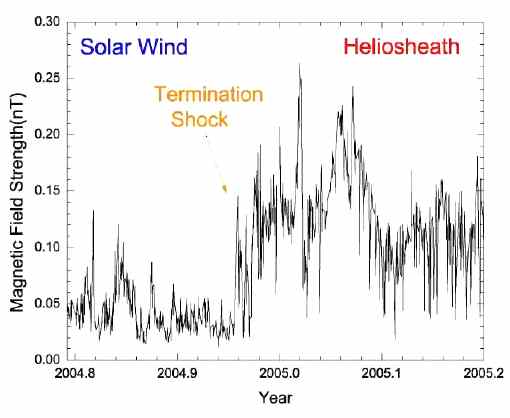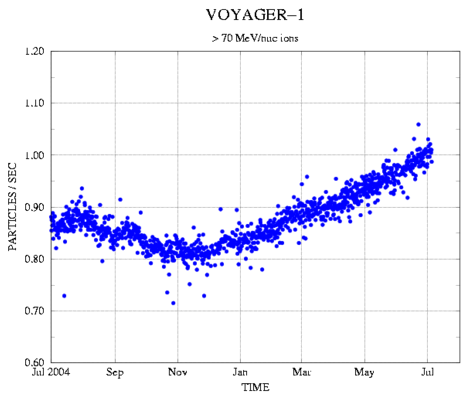 |
|
(Files in red–history) |
The Boundary of the Solar WindThe solar wind may be viewed as a rarefied gas of charged particles, expanding outwards. It is a somewhat unusual gas, a "plasma" of charged particles: its particles are bound together by the magnetic field surrounding them, not by mutual collisions, the way molecules in the air we breathe interact. But like an ordinary gas, it too can exert a pressure As the solar wind spreads out radially, its density keeps decreasing, like light spreading from a lamp--as its distance R from the center of the Sun increases, its density drops in proportion to 1/R2, getting smaller and smaller. The magnetic field also weakens, approximately like 1/R; the field of a bar magnet in empty space would weaken at a much faster rate, but here the magnetic intensity is kept up by the charged particles it contains, belonging to the solar wind. The pressure exerted by the solar wind depends on both density and magnetic field; because both these get increasingly weaker as the gas spreads out from the Sun, so does the pressure. But another gas, extremely rarefied, fills space outside the solar system, the "interstellar medium." One may well expect the solar wind's expansion to end wherever its pressure balances that of the interstellar gas. Some cautions need to be observed, though. First, the balancing pressure can only come from interstellar plasmas, from charged particles in interstellar space and from the magnetic fields which accompany them. Neutral particles--such as molecules of ordinary air--will see no obstacle: the magnetic field exerts no force on them, and solar wind particles are so far apart (centimeters or inches) that collisions practically never occur. |
Neutral atoms (or molecules) therefore easily penetrate the solar system, until somewhere--say, near Earth's orbit--sunlight becomes intense enough to knock off an electron. When that happens the atom suddenly becomes subjected to electric and magnetic forces, and gets caught up by the solar wind. This can happen, and has been studied, but won't be further discussed.
Standing ShocksSecond, the behavior of gas depends on the speed of sound, which controls the propagation of disturbances. Solar wind particles are linked by their embedded magnetic field rather than by collisions, so the speed that counts has to do with "magnetic pressure" rather than ordinary gas pressure, produced by collisions. That speed is known as the "Alfvén speed" after the Swede Hannes Alfvén who in 1944 predicted waves in a plasma which advance at the speed. The solar wind is indeed "superalfvenic", moving at typically 2-3 times the Alfvén speed.A supersonic flow which encounters an obstacle undergoes a double transition. First it forms a "standing shock," a transition where the flow abruptly slows down below the speed of sound, while its density increases. This transition is also associated with the conversion into heat of much of the kinetic energy of the ordered supersonic flow. That makes a great difference for space vehicles re-entering the atmosphere from orbit: the space shuttle, for instance, must lose an enormous amount of kinetic energy before landing, and it benefits from the fact that most of that energy is converted to heat not when the supersonic air flow hits the heat-shield tiles, but some distance before that, in the standing shock ahead of the vehicle. Similarly, when the solar wind hits an obstacle, it forms a "bow shock" ahead of it, slows down below the Alfvén speed and only then, some distance further downstream, interacts with the obstacle. Planetary magnetic fields, such as that of the Earth, are a good example. The Earth's bow shock forms about 13 Earth radii sunward of Earth--that is the closest point in a curved surface, similar to what you get when you rotate a hyperbola around its axis of symmetry. The solar wind then continues, slower and denser, until it is finally deflected by the Earth's magnetic field at the "magnetopause," at a distance of about 10.5 Earth radii. The termination ShockThe same could happen with the obstacle faced by the distant solar wind when it encounters the interstellar plasma and magnetic field. Scientists have long claimed that the first sign of such an encounter would be a "termination shock" where the solar wind abruptly slowed down, to be followed by the "heliopause" where it achieved pressure balance with the interstellar medium. It might then be deflected away from the boundary, the way it is deflected at the magnetopause of the Earth. The region inside, dominated by the solar wind, was named "heliosphere," even though (like the magnetosphere) its shape is probably rather non-spherical.Theories suggested that the shock would occur at about 50-100 AU (astronomical units; one AU is the mean Sun-Earth distance), well beyond the orbits of Neptune (30 AU) and Pluto (40 AU). Front runner among NASA's long-distance space probes is Voyager 1, launched in 1977 towards Jupiter and Saturn. As its distance grew, its signals weakened and needed special handling by NASA's engineers, with a very slow signal rate. Its electricity generators, using heat from radioactive plutonium, also lost some power, and its solar wind detector has died. Year after year the investigators waited--interpreting noisy periods as the approach of the termination shock, only to see the noise quiet down again. No doubt betting pools wagered good money on when and where the crossing would happen. And then it happened, just when no one was watching. The CrossingOn December 15, 2004 Voyager 1 was about 94 AU from the Sun, and observed an interplanetary magnetic field of 0.05 nT (nanotesla) or less. For comparison, the field in the solar wind near Earth can be 5-10 nT, and on the Earth's surface it is typically 50,000 nT. Voyager is not monitored around the clock, only about 8 hours per day, and when the magnetic field was next observed on December 17, its intensity had risen to 0.12-0.15 nT, and stayed at a higher level (see image below, courtesy of Dr. L. Burlaga). Some time between those observations, a transition was crossed. Voyager can no longer observe the solar wind, but the magnetic field is a good measure of solar wind pressure and velocity: at some time between these observations, the solar wind velocity must have dropped steeply. Apparently the termination shock had been crossed, which was also signaled by an increase of the magnetic fluctuation level ("turbulence").
What next? The flow of the solar wind is not constant, and at some time in the future its volume and/or speed could increase to where the termination shock is pushed outwards and passes over Voyager 1 again. Spacecraft close to the Earth's bow shock often observe such swings. However, another instrument aboard Voyage 1 suggests this is not imminent, a detector for low energy cosmic ray ions of 70 MeV and up. Since the crossing of the termination shock the flow of these particles has steadily increased (see figure below).
Next Stop: #19. The Magnetopause
Timeline Expanded timeline Glossary Author and Curator: Dr. David P. Stern |

